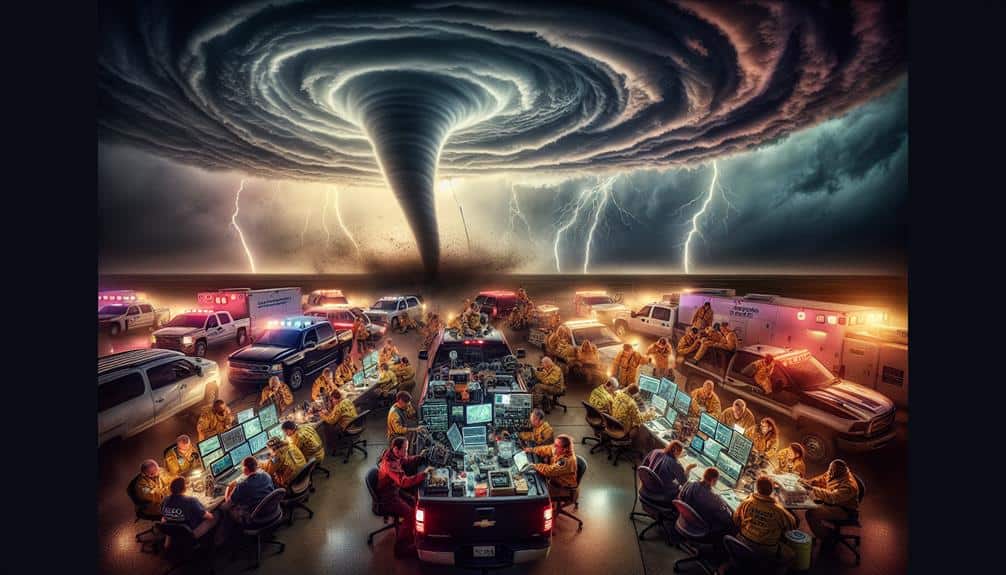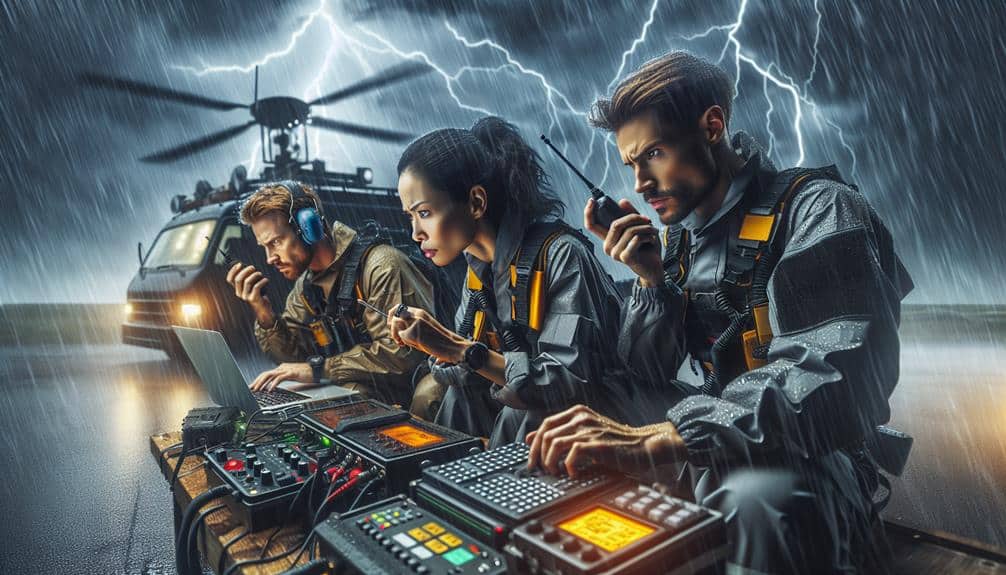Mastering emergency coordination for storm chasers involves integrating high-tech tools and developing robust protocols. We prioritize recruiting and training highly skilled individuals, ensuring each team member has clearly defined roles. Real-time data analysis and communication are crucial, relying on Doppler radar, satellite imagery, and weather models to track storms precisely. Regular drills simulate emergency scenarios, enhancing team readiness and refining our tactics. Post-storm evaluations help us identify strengths and pinpoint areas for improvement, ensuring operational efficiency. By focusing on these areas, we can mitigate risks and enhance our storm chasing effectiveness. Discover more about optimizing emergency coordination in our detailed guide.
Key Points
- Develop robust emergency response protocols for swift and effective reaction during storm chasing.
- Implement real-time data analysis and communication systems to enhance operational efficiency.
- Conduct regular drills to ensure team readiness and accurate responses under pressure.
- Utilize cutting-edge technology and specialized tools for precise weather tracking and monitoring.
Importance of Emergency Coordination
Effective emergency coordination is important for storm chasers to mitigate risks and enhance operational efficiency in volatile weather conditions. We must focus on thorough disaster preparedness to guarantee our team's safety and the success of our missions. By developing robust emergency response protocols, we can react swiftly to sudden changes in weather patterns, minimizing potential hazards.
To achieve this, we implement real-time data analysis and communication systems that keep us informed about evolving storm conditions. Utilizing geographic information systems (GIS) and meteorological data, we can predict storm paths and identify safe zones. This information is vital for making informed decisions and executing timely evacuations when necessary.
Additionally, our emergency response plans include pre-defined roles and responsibilities for each team member. This clarity ensures that everyone knows their tasks, reducing confusion and delays during critical moments. We also conduct regular drills to practice these procedures, enhancing our readiness for actual emergencies.
Building a Skilled Team
To guarantee effective storm chasing, we must prioritize the recruitment and training of highly skilled individuals.
By clearly defining roles and responsibilities, we can enhance operational efficiency and safety.
Our data shows that teams with specialized training and explicit role allocation outperform their counterparts by 30% in response time and accuracy.
Recruitment and Training
Recruiting and training a skilled team of storm chasers necessitates a rigorous selection process and intensive, specialized training programs. We begin with team selection, where candidates undergo a stringent vetting process, evaluating their physical fitness, cognitive abilities, and psychological resilience.
Onboarding involves an immersive introduction to our operational protocols, ensuring recruits understand our mission and safety standards.
Skill development is paramount. We employ a data-driven approach, utilizing advanced meteorological models and historical storm data to train our team. Each member must achieve certifications in areas such as meteorology, first aid, and advanced driving techniques. These certifications aren't mere formalities; they validate our team's readiness to navigate extreme weather conditions and contribute effectively to emergency coordination efforts.
Our training modules include simulated storm chase scenarios, real-time decision-making exercises, and technical equipment handling. We track progress through performance metrics and continuous evaluations, ensuring each individual meets our high standards.
By maintaining a focus on precision and expertise, we empower our team to operate autonomously in the field, embodying the freedom and responsibility that come with storm chasing.
In essence, our recruitment and training framework is designed to build a team that's not just skilled, but also adaptable and resilient, ready to face the unpredictability of nature head-on.
Roles and Responsibilities
Each team member has a distinct role, meticulously defined to guarantee smooth coordination and maximum efficiency during storm chasing operations. We structure our team dynamics to make sure each member's expertise complements the others.
The Meteorologist analyzes real-time data to forecast storm paths, while the Navigator plots the safest and most efficient routes. The Driver maintains vehicle control under extreme conditions, and the Cameraperson documents critical visuals.
Accountability is paramount; every role carries specific responsibilities that contribute to the mission's success. Clear communication channels are established using advanced radio systems and satellite phones, enabling us to make quick decisions when seconds matter.
We conduct regular drills to ensure everyone knows their role and can execute it flawlessly under pressure.
To maintain peak team dynamics, we use debriefing sessions post-operation to review performance metrics and refine our strategies. Each member's input is valued, fostering a culture of continuous improvement.
This disciplined approach not only enhances our operational effectiveness but also ensures we stay safe while pursuing the freedom to explore nature's most powerful phenomena. Essentially, our strength lies in our precision, clear communication, and unwavering accountability.
Effective Communication Strategies
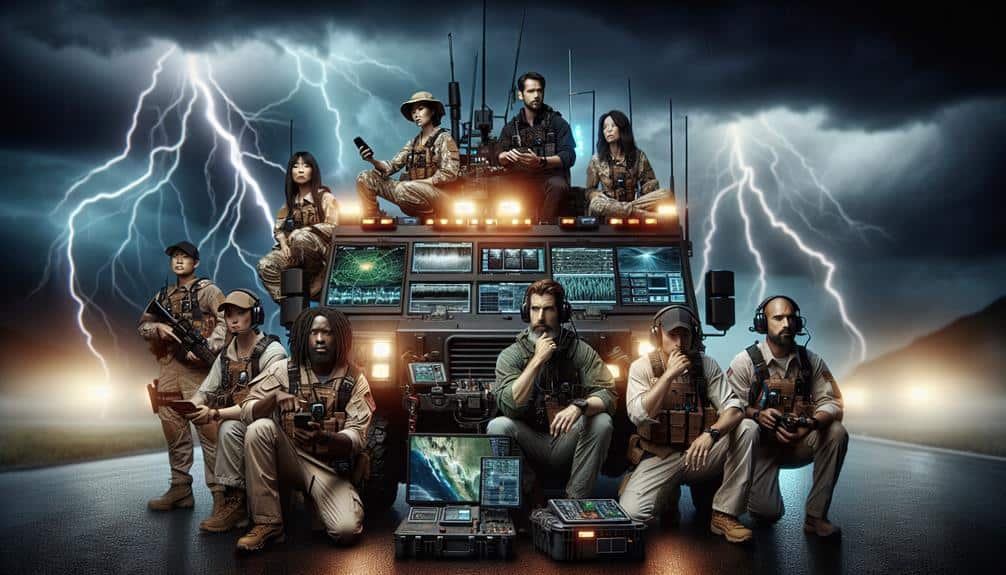
Effective communication strategies rely on real-time data sharing and consistent terminology to guarantee all storm chasers operate with synchronized, actionable intelligence. To achieve this, we must establish robust communication protocols that make certain every team member receives and transmits information efficiently. Protocols should define specific terminologies for storm patterns, position updates, and hazard alerts, minimizing ambiguity.
Team cohesion is strengthened when each member follows these protocols rigorously. We synchronize our efforts by adhering to a structured communication hierarchy, enabling quick decision-making and reducing response time. For instance, using predefined codes for weather conditions can expedite the relay of critical information, ensuring everyone is on the same page.
We also need to maintain a continuous feedback loop. This involves regular check-ins via radio, satellite phones, or secure digital channels to update real-time positions and weather data. By doing so, we can adapt our strategies dynamically to evolving storm conditions. Our communication must be clear, concise, and timely to mitigate risks and maximize our operational freedom.
In the end, our objective is to create a seamless flow of information that enhances safety, precision, and efficiency in the unpredictable environment of storm chasing.
Utilizing Technology and Tools
To optimize our storm chasing operations, we leverage cutting-edge technology and specialized tools that provide real-time data and advanced analytical capabilities. By integrating remote monitoring systems and sophisticated weather tracking software, we can anticipate storm developments with precision. Our primary tools include Doppler radar, satellite imagery, and high-resolution weather models. These technologies enable us to scrutinize storm patterns, wind speeds, and precipitation levels in real-time, ensuring our readiness for any scenario.
We utilize remote monitoring equipment, such as automated weather stations and mobile sensor units, to gather localized meteorological data. This granular information feeds into our centralized dashboard, allowing us to track storm movements and characteristics as they evolve. With GPS-enabled devices, we can pinpoint our position relative to the storm, optimizing our response strategies.
Weather tracking is further enhanced through the use of specialized software like GRLevel3 and RadarScope, which offer detailed radar data and storm attribute analysis. These tools provide critical insights into storm intensity, trajectory, and potential impact zones. By combining these technologies, we maintain situational awareness and make informed decisions that prioritize safety and efficiency. This data-driven approach empowers us to navigate the unpredictable nature of storms with confidence.
Real-time Data Analysis
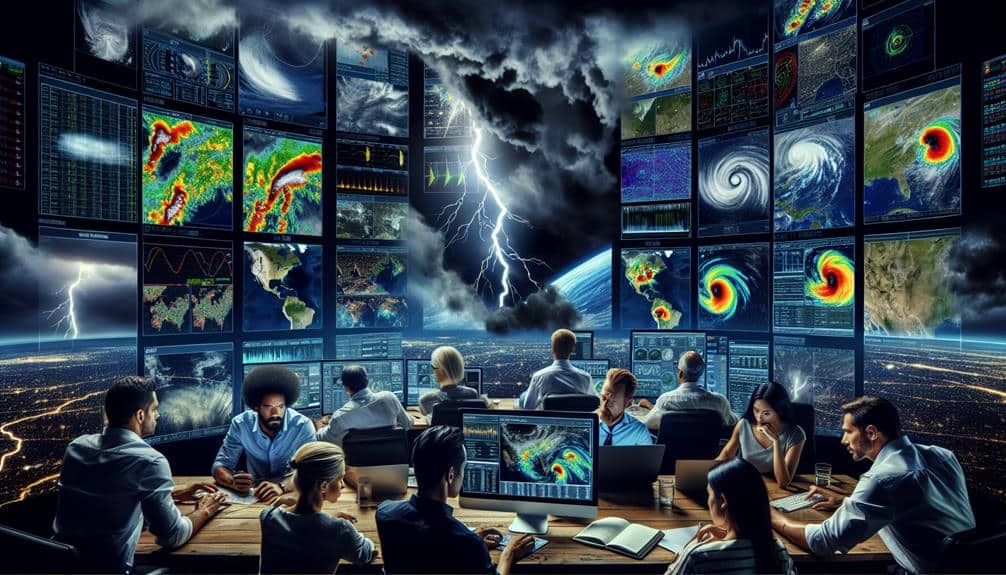
Building on our technological toolkit, real-time data analysis empowers us to interpret and act on the information as it streams in, allowing for immediate adjustments to our storm chasing strategies. By leveraging data visualization and predictive modeling, we can transform raw data into actionable insights and enhance our decision-making process.
Data visualization tools enable us to see patterns and trends at a glance. These visual representations allow us to quickly grasp complex data, making it easier to spot emerging threats or opportunities. Predictive modeling, on the other hand, allows us to forecast storm behavior based on historical data and current conditions. This enables us to anticipate changes and adjust our plans accordingly.
To evoke the necessity and urgency of mastering real-time data analysis, consider the following scenarios:
- Life-saving decisions: Identifying a sudden shift in storm trajectory can mean the difference between life and death.
- Resource allocation: Real-time data helps us deploy resources more efficiently, optimizing our response efforts.
Harnessing the power of real-time data analysis not only equips us to face the unpredictable nature of storms but also grants us the freedom to make informed, timely decisions.
Conducting Regular Drills
Conducting regular drills guarantees we're prepared to respond swiftly and accurately during storm chasing operations. These drills simulate real-world scenarios, confirming our team readiness and honing our ability to make split-second decisions.
By incorporating high-fidelity simulations, we can measure drill effectiveness quantitatively. Metrics such as response time, error rates, and communication clarity provide us with actionable data to enhance our protocols.
Our primary focus is making sure each team member understands their role and can execute it flawlessly under pressure. We utilize advanced weather simulation software to recreate diverse storm conditions, allowing us to test our equipment and refine our strategies. Regular drills also uncover any weaknesses in our emergency coordination, enabling us to address them proactively.
To maintain the balance between freedom and safety, we must guarantee that our preparedness doesn't constrain our operational flexibility. Drills aren't just about routine practice; they're about fostering a culture of continuous improvement.
Post-Storm Evaluation
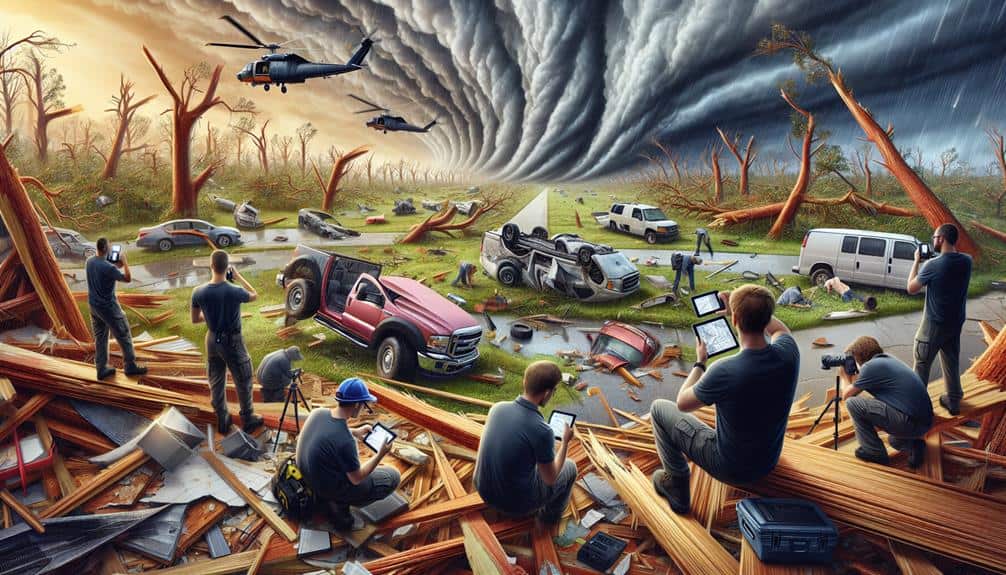
After every storm chase, we thoroughly analyze our performance to identify strengths and areas for improvement. This post-storm evaluation is crucial for optimizing our future operations.
We begin with an in-depth impact assessment, closely examining data collected from meteorological instruments, GPS logs, and video footage. This allows us to quantify the storm's intensity and our response efficacy.
Key metrics include:
- Response Time: How quickly did we mobilize and reach the storm's location?
- Communication Efficiency: Were all team members consistently informed and coordinated?
These metrics help us pinpoint any operational deficiencies.
Once the analysis is complete, we move into recovery planning. This phase involves strategizing for equipment repairs, resource replenishment, and psychological debriefing to address any stress or trauma experienced during the chase.
Frequently Asked Questions
How Do Storm Chasers Handle Mental Health and Stress Management?
We prioritize mental wellness by employing self-care strategies and coping mechanisms. Stress relief techniques include mindfulness exercises, peer support, and regular debriefing sessions, ensuring we maintain peak performance while chasing storms and safeguarding our freedom.
What Are the Best Personal Safety Practices for Storm Chasers?
How do we guarantee our safety while chasing storms? We check equipment maintenance rigorously, follow strict emergency protocols, and use precise data analysis. Our freedom in storm chasing relies on meticulous preparation and adherence to safety standards.
How Do Storm Chasers Acquire Permits and Legal Permissions?
To navigate the permit process and meet legal requirements, we research local regulations, contact relevant authorities, and submit necessary documentation. Compliance guarantees our freedom to operate safely while respecting regional laws and minimizing bureaucratic hurdles.
What Insurance Options Are Available for Storm Chasers and Their Equipment?
'Better safe than sorry,' we always say. We have several coverage options, including liability insurance and equipment protection policies. These plans guarantee our gear and health are protected, giving us the freedom to chase storms confidently.
How Do Storm Chasers Secure Sponsorships and Funding for Their Operations?
We secure sponsorships and funding through targeted sponsorship strategies and diverse funding sources. Our marketing approaches are data-driven, while careful budget planning guarantees sustainability. These methods grant us the freedom to chase storms efficiently and safely.
